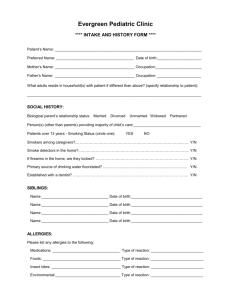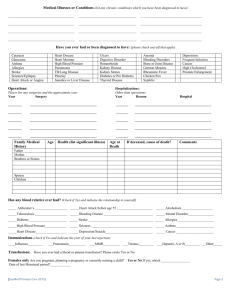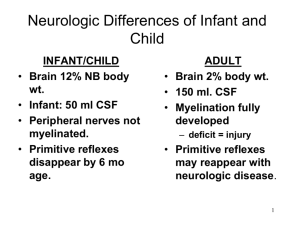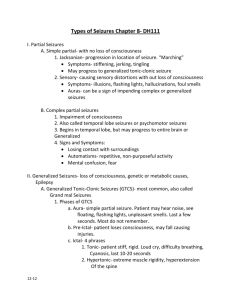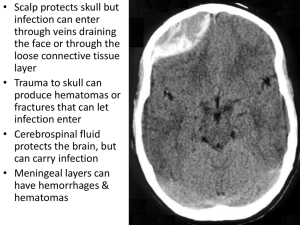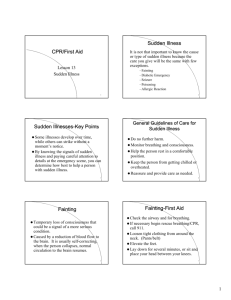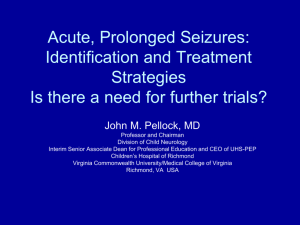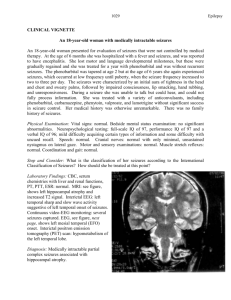Chapter 5 Conditions Affecting Children`s Health
advertisement
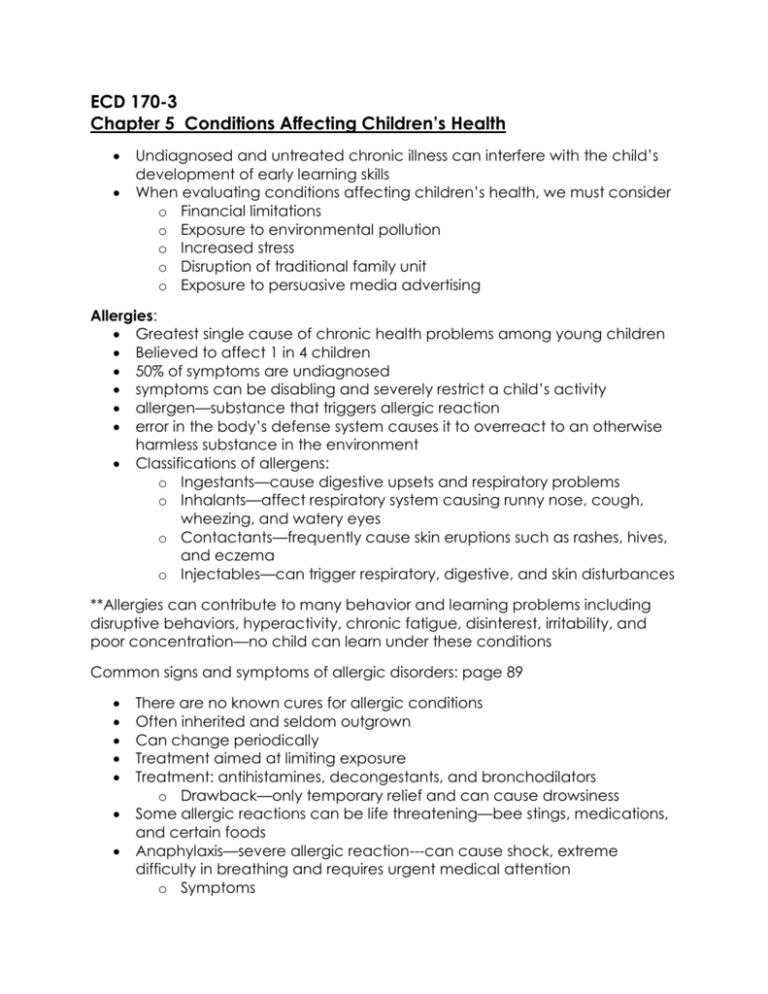
ECD 170-3 Chapter 5 Conditions Affecting Children’s Health Undiagnosed and untreated chronic illness can interfere with the child’s development of early learning skills When evaluating conditions affecting children’s health, we must consider o Financial limitations o Exposure to environmental pollution o Increased stress o Disruption of traditional family unit o Exposure to persuasive media advertising Allergies: Greatest single cause of chronic health problems among young children Believed to affect 1 in 4 children 50% of symptoms are undiagnosed symptoms can be disabling and severely restrict a child’s activity allergen—substance that triggers allergic reaction error in the body’s defense system causes it to overreact to an otherwise harmless substance in the environment Classifications of allergens: o Ingestants—cause digestive upsets and respiratory problems o Inhalants—affect respiratory system causing runny nose, cough, wheezing, and watery eyes o Contactants—frequently cause skin eruptions such as rashes, hives, and eczema o Injectables—can trigger respiratory, digestive, and skin disturbances **Allergies can contribute to many behavior and learning problems including disruptive behaviors, hyperactivity, chronic fatigue, disinterest, irritability, and poor concentration—no child can learn under these conditions Common signs and symptoms of allergic disorders: page 89 There are no known cures for allergic conditions Often inherited and seldom outgrown Can change periodically Treatment aimed at limiting exposure Treatment: antihistamines, decongestants, and bronchodilators o Drawback—only temporary relief and can cause drowsiness Some allergic reactions can be life threatening—bee stings, medications, and certain foods Anaphylaxis—severe allergic reaction---can cause shock, extreme difficulty in breathing and requires urgent medical attention o Symptoms Wheezing and difficulty breathing Swelling of the lips, tongue, and/or eyelids Itching and hives Nausea, vomiting, and/or diarrhea Anxiety or restlessness Blue discoloration around mouth and nailbeds We can not ignore emotional affects of allergies on children Don’t allow allergies to be a means of gaining attention or special privileges Teach to be independent and self-confident when coping with their problems Asthema: Increasing health problem Chronic and acute respiratory disorder Affects boys twice as often as girls Significantly higher among minority children and those living in poverty Factors that trigger attacks: o Airborne allergens o Foods o Secondhand cigarette smoke o Respiratory infections o Stress o Changes in temperature o Vigorous exercise Symptoms of acute attacks: o Wheezing o Coughing o Difficulty breathing, especially on exhalation Many children will outgrow asthma attacks as the size of passageways increase with age. Encourage children to participate in regular activity as their condition permits. Attention Deficit Disorders (with or without hyperactivity) Hyperactivity—a condition characterized by attention and behavior disturbances, including restlessness, impulsive and disruptive behaviors. Often inappropriate label for children behaving within normal limits o Young children, by nature, are exceedingly energetic, curious, impatient, and restless. ADD—a developmental disorder that includes a wide range of learning and behavior problems. ADHD—ADD with hyperactivity Definition—a syndrome of attention and behavior disturbances that may improve when stimulant-type drugs are administered ADD/ADHD is known to affect boys four to five times more often than girls Often runs in families Typical Behaviors o Explosive o Inattentive o Fidgety o Aggressive o Defiant o Forgetful o Easily frustrated o Clumsy Guidelines suggest that the behaviors must have been present before a child reaches ages seven and observed for at least six months Management: o No one simple method o Individualized approach o Medications: Ritalin, Cylery, and Dexedrine Stimulant and antidepressants tend to have opposite affect on children with ADD/ADHD---calming affect Criticized for overuse Sometimes viewed as the easy way out Often prescribed before other intervention is tried Medication alone is not the cure—symptoms usually reappear when medication is stopped o Medication must be combined with behavior management Basic Principles: o Creating a structured environment o Establishing a daily routine that is consistent and predictable o Giving directions that are clear and easy for the child to follow o Offering praise and positive reinforcement o Providing experiences that are challenging yet within the skill and tolerance level of the child o Providing opportunities for developing new interests, especially physical activities where children can channel excess energy and learn to relax Dietary management has also been suggested for treatment No one method will specifically work for every child Diabetes: Relatively low among children Chronic health problem that occurs when the pancreas does not produce a sufficient amount of insulin. Insulin is necessary for the storage and release of glucose (energy) that is obtained from the digestion of carbohydrates. If inadequate…sugars will circulate freely in the blood rather than be stored for later use. Onset is usually abrupt Symptoms o Rapid weight loss o Fatigue and/or weakness o Nausea or vomiting o Frequent urination o Dehydration o Excessive thirst and/or hunger o Dry, itchy skin Children develop juvenile or Type 1 diabetes Must be giving injections of insulin daily Teachers need to learn about dietary restrictions and medical procedures Plans for handling medical emergencies must be enacted Teachers must help children learn to accept their condition and lead welladjusted lives Eczema Inflammatory skin condition commonly associated with allergies, especially to foods and substances that com in contact with the skin First appear on cheeks and/or forehead of infants and toddlers Older children develop dry, itchy, scaly areas on outer surfaces of knees, elbows, wrists, and back of hands First line of defense is identifying and eliminating allergens Fatigue Children to experience fatigue and listlessness Cause and symptoms are usually temporary o Growth spurts o Late bedtimes o Moving o Recovery from illness o Birth of sibling o Participation in too many activities Repeated or prolonged fatigue is not normal for young children and should be investigated due to negative affect on growth and development Can be indicative of other health problems including: o Poor nutirition o Chronic infection o Anemia o o o o Allergies Hepatitis Endocrine (hormonal) disorders Heart disorders Fetal Alcohol Syndrome and Fetal Alcohol Effects Estimated over 45,000 babies are born each year with FAS/FAE Most serious consequences tend to occur during the first two or three months when all major fetal organs are developing Symptoms o Low birth weight o Mental retardation o Facial abnormalities o Behavior and learning problems No are no studies to establish a safe level of alcohol intake---stop drinking Lead Poisoning Not exclusively associated with poverty and inner city populations Typically higher among children living in these areas primarily because of lead based paints Young children are especially vulnerable Frequently put toys and hands in mouths and their body more readily absorb lead Brain and nervous system are especially sensitive Symptoms develop slowly and affect the child’s CNS Symptoms o Irritability o Loss of appetite o Headaches o Unexplained abdominal pain o Constipation o Nausea o Listlessness o Learning and behavior problems o Elevated levels—4-5% decrease in IQ Those at risk should be screened for lead poisoning between 6 and 72 months of age Most effective preventable measure—public awareness and community education Seizures A temporary interruption of consciousness sometime accompanied by convulsive movements Describes a cluster of symptoms rather than a particular disease Caused by abnormal electrical impulses in the brain Abnormal activity leads to involuntary and uncontrollable movements in various body party Some are momentary lapse of attention or interruption of thought while others may last several minutes and cause vigorous, spasmodic contractions of the entire body. Temporary loss of consciousness, frothing, and loss of bowel and bladder can occur Contributing factor—heredity in some families o Exact cause may never be identified Conditions know to initiate seizure activity in children o Fevers that are high or rise rapidly o Brain damage o Infections o Tumors o Head injuries o Lead, mercury, and carbon monoxide poisoning o Hypoglycemia o Drug reactions Types: Febrile seizures: o Triggered by high fever o 5 to 10% of infants and children under 3 o May cause loss of consciousness and have involuntary jerking movements o Stops when fever subsides Petit mal seizures o Momentary loss of attention including repeated incidences of daydreaming, staring off in space, blank appearance, brief fluttering of eyes, temporary interruption of speech or activity, twitching or dropping of objects o Children 4 to 10 years o Characterized by a brief loss of consciousness o Usually lasting 10 to 30 seconds o May suddenly stop an activity and resume it almost as quickly once the seizure subsides Grand mal seizures o Most common form of seizure disorder o Convulsive movement of entire body o Aura or warning immediately prior can be a sound, smell, taste, sensation, or visual cue o Sudden rigidity or stiffness (tonic phase) is followed by loss of consciousness and generalized muscular contractions (clonic phase) Focal seizures o Characterized by involuntary convulsive movements that begin at the tip of an extremity and spread toward the body trunk o Child does not always lose consciousness Temporal lobe seizures o Distinguished by spontaneous episodes of unusual behavior which is considered inappropriate for the circumstance. Ie..run in circles, cry for no reason o Common to experience aura before this seizure begins Most seizures can be controlled with medication Document, Document, Document Teachers play an important role in the inclusion of children with seizure disorders in child care programs by arranging environments and mastering emergency plans A teacher’s own reactions or displays of genuine acceptance can go a long way in teaching understanding and respect for persons with special problems Sickle Cell Anemia An inherited disorder that affects the ability of red blood cells to carry oxygen Primarily affects the African-American population as well as Mediterranean, Middle Eastern, and Latin America descents 10% of African Americans carry the trait Abnormal formation of red blood cells, shaped like a common or sickle rather than round shape Can slow and occasionally block blood flow to the body Clumping of deformed blood cells results in period of acute illness called crisis Crisis can be triggered by infection, injury, strenuous exercise, or dehydration Symptoms include: fever, severe abdominal and leg pain, vomiting, and ulcers on arms and legs Children are often small for their age and are irritable and tire easily No known cure Genetic counseling can help parent who are carriers decide if they will produce off-spring Antibiotics on a regular basis can prevent infections which are the leading cause of death Frequent blood transfusions can be helpful in preventing acute crisis.

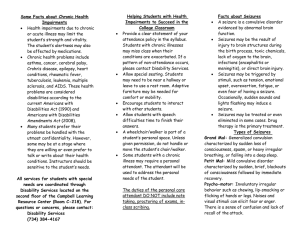
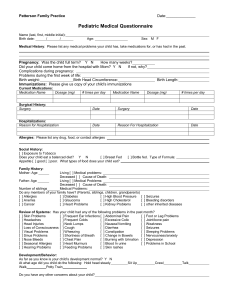
![Pediatric Health Histroy.Initial child.d[...]](http://s3.studylib.net/store/data/006593866_1-7ecae25d724665d2a564380f86b41e96-300x300.png)
